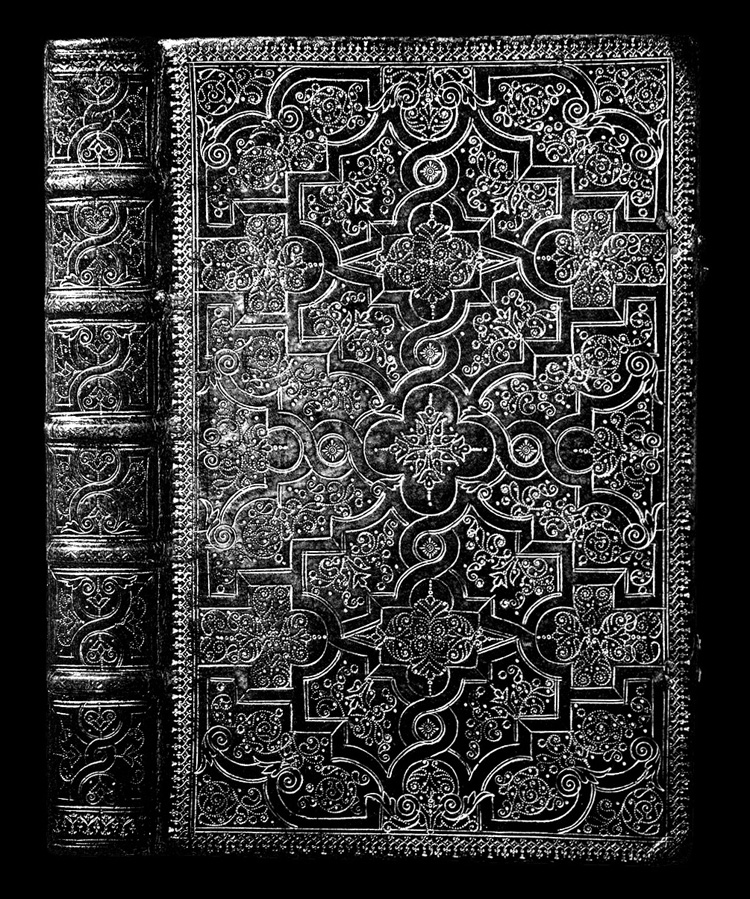

| The binding reproduced above, is Plate 69 from H.M.Nixon's 1956 London publication entitled Broxbourne Library. This plate is titles 'LATE FANFARE BINDING BY ANTOINE RUETTE c.1644. Below I have included Nixon's description of this item and his brief summary of Antoine Ruette's work. |
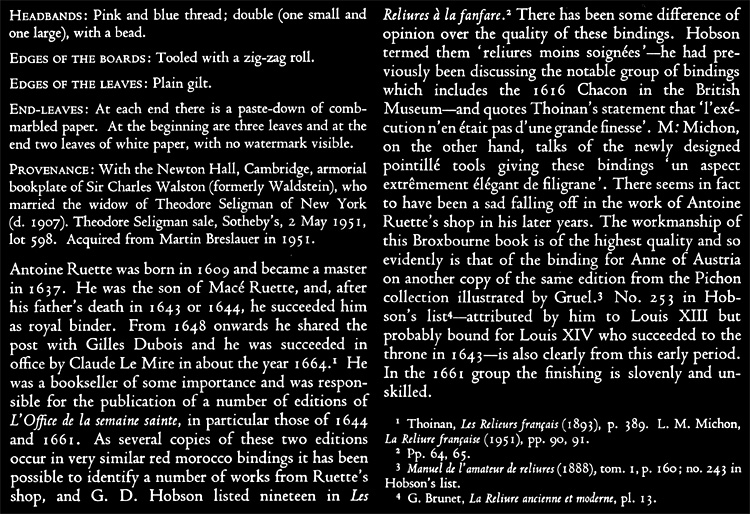
|
In our study of decorative bindings attributed to Antoine Ruette, the above specimen must be considered one of the more important. Esmerian lists this example as #4 in his Tableau VI ANTOINE RUETTE 1640-1669. In that list he gives only one earlier example (1640) and then lists 3 examples of Ruette's own 1644 OSS publication. Recent evidence now suggests that Macé Ruette actually died in 1638, which means that Antoine Ruette was probably the King's binder from that year onwards. Esmerian and Nixon were both unaware of this fact and placed his death as being some six years later, or around 1644. This detail may seem rather unimportant, however it may be that some bindings that were produced in this period, may have been incorrectly attributed by most authors to Mace Ruette. A closer study of Antoine Ruette's early work may enable us to pinpoint certain tools and details that will help to identify the works of these two celebrated artists. My interest here, is to try to discover which tools were used by both binders, and then identify those that can be attributed solely to Antoine Ruette. Nixon's reproduction of this 1644 binding is of an unusually high quality and from it we can extract some excellent imprint samples that will be a valuable aid in future comparative studies. Below I have reproduced an enlargement of two Esmerian imprint models. ar-1a and ar-1b, these are the first two Antoine Ruette imprint models illustrated in Esmerian's Tableau VI. (click here to link to further details concerning the Tableau VI imprints) |

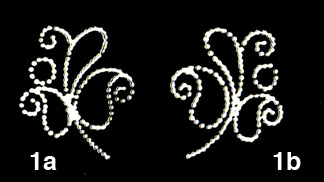
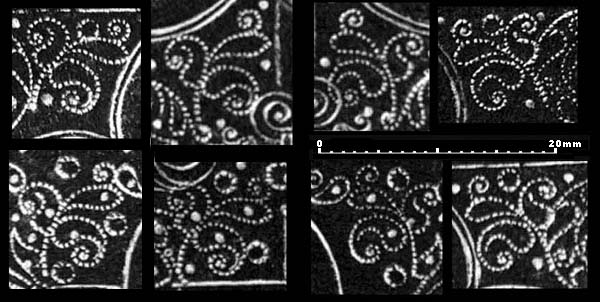
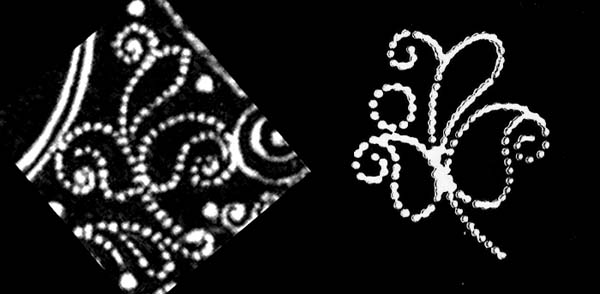
| Of all the Esmerian imprint models, this first Ruette example would have to be the one of the most inaccurate. While many of Esmerian's models are very reliable this particular example seems a curious departure from the norm. However we need not dwell on this, other than the reminder that models are nowhere near as good as high resolution images. We should note however that Ruette often embellished this imprint with the small pointillé circle that we see in the Esmerian model, however it is a separate tool and not always present. |
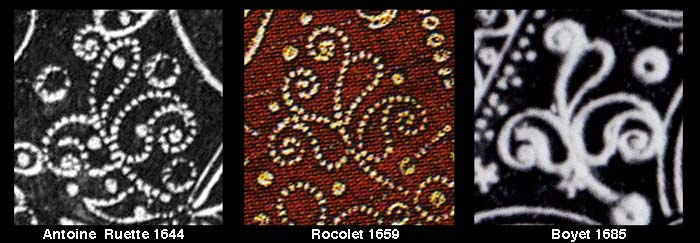
| I have not found the ar-1a, 1b imprints in the bindings of Macé Ruette, and it may be that Antoine Ruette was the first to use tools of this form. A nearly identical set of these tools can be seen on a 1659 Rocolet binding as well as similar forms used by Boyet in some of his early bindings c. 1685. It will be useful therefore to point out a number of identifying characteristics unique to Ruette example. |
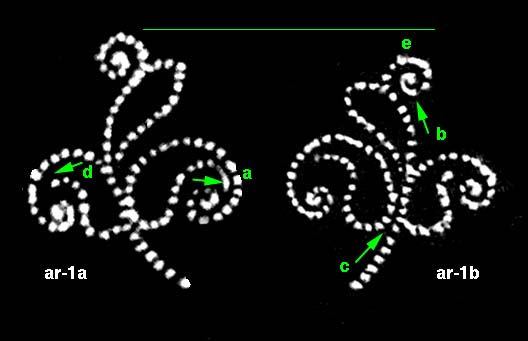
| In Comparative Diagram 4, I have indicated some of the more important details that will help to identify these imprints. The first most obvious 'flaw' is that the lower edge of the leaves does not join the upper edge, in every case there is a gap as in the example shown by arrow 'd'. If you compare the actual imprints with the Esmerian models you will notice that are no gaps in the models (see also the Rocolet example). The gaps seem an unexpected detail or 'flaw', also this flaw is strangely accented at 'a' where we find a long segment that runs parallel to the outer pointillé edge. Another long segment can be seen at 'b'. I have placed arrow at 'c' to indicate the complete separation of the leaf from the stem. This would seem an unusual feature, however the overall form of these tools seems to be unusual and somewhat reminiscent of certain azured tools of the previous century. Also one should note that 1b is significantly smaller than 1a, which I have indicated by the extended line at 'e'. |
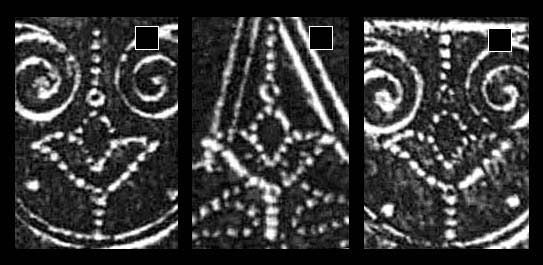
| I would like to point out another tool which we see playing an important roll in this 1644 binding. The beginnings of this form can perhaps be traced to the early pointillé work of Macé Ruette. (see Macé Ruette - Early Methods) who used a tool of this general shape. Working with small pointillé tools, Macé Ruette often created complex centerpiece arrangements in which this form played an important roll as a culminating or cardinal element. |
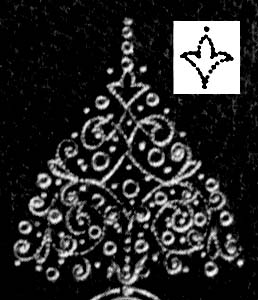
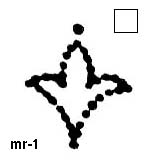
|
In Raphael Esmerian's Tableau Synoptique II - ATELIER DE MACÉ RUETTE environ 1606-1638. this imprint is the first of a selection of imprint models. As an aid in cataloguing these models I have numbered them in the order presented, thus this imprint becomes mr-1 (Macé Ruette one). Esmerian has added a crowning dot to his imprint model however careful inspection of a number of samples indicates that the tool does not have this elaboration. It is interesting however to note that small crowning rings and dots were often added to this imprint, possibly to accentuate its culminating effect. I can imagine someone thinking that it would be handy to make something similar with the rings and dots combined in one tool. We can see just this sort of tool in the relatively minimalist pointillé tool kit of the Maitre Doreur and a nearly identical copy of the Maitre Doreur tool in the Badier collection. |
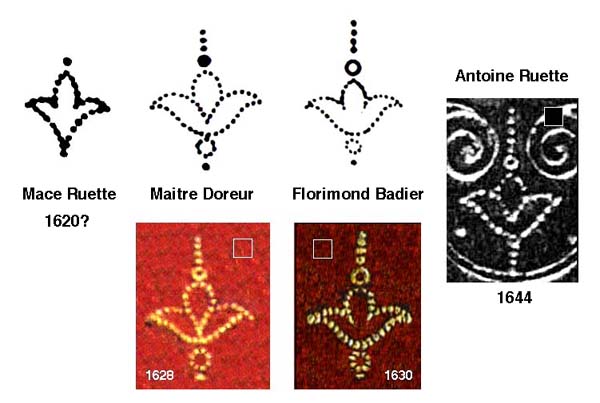
|
In Comparative Diagram 6, I have gathered together these models and imprints, all are shown at the same enlarged scale. These tools are actually very small compared to most and yet they have proved to be some of the most important, and often imitated, forms. This tool seems to be one Florimond Badier's favorites to which he often added further elaborations to create interesting forms which were then copied and elaborated upon by other artists, thus we can see the original form serving as a base in the creation of dozens of spin off designs that later played a larger role in pointillé decoration. I find it strange therefore that we do not find an imprint model for this particularly important tool in Esmerian's Synoptic Table for Antoine Ruette. I have, provisionally catalogued it as ar-2-1. It may be that this tool as well as ar-1 are unique to Antoine Ruette |
|
See the next page Antoine Ruette according to the experts. Return to the previous page. Another Ruette Binding |
| Go to Digital Alchemy | Click on this link to visit cyclopaedia.org |